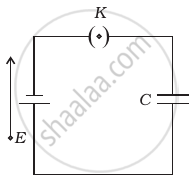Advertisements
Advertisements
प्रश्न
A slab of material of dielectric constant K has the same area as that of the plates of a parallel plate capacitor but has the thickness d/2, where d is the separation between the plates. Find out the expression for its capacitance when the slab is inserted between the plates of the capacitor.
उत्तर
Initially when there is vacuum between the two plates, the capacitance of the two parallel plate is, `C_0 = (epsi_0A)/d`
Where, A is the area of parallel plates.
Suppose that the capacitor is connected to a battery, an electric field E0 is produced.
Now if we insert the dielectric slab of thickness t=d/2 the electric field reduces to E.
Now the gap between plates is divided in two parts, for distance t there is electric field E and for the remaining distance (d-t) the electric field is E0.
If V be the potential difference between the plates of the capacitor, then V=Et+E0(d-t)
`V=(Ed)/2 + (E_0d)/2 =d/2 (E +E_0) (therefore t =d/2)`
`=> V=d/2 ((E_0)/K +E_0) (dE_0)/(2K) (K+1) (As,(E_0)/E = K)`
Now, `E_0 =σ/epsi_0 = q/(epsiA )=>V = d/(2K) q/(epsi_0A) (K +1)`
we know, `C = q/V = (2Kepsi_0A)/(d(K+1))`
APPEARS IN
संबंधित प्रश्न
Draw a neat labelled diagram of a parallel plate capacitor completely filled with dielectric.
What is the area of the plates of a 2 F parallel plate capacitor, given that the separation between the plates is 0.5 cm? [You will realize from your answer why ordinary capacitors are in the range of µF or less. However, electrolytic capacitors do have a much larger capacitance (0.1 F) because of very minute separation between the conductors.]
A parallel-plate capacitor is charged to a potential difference V by a dc source. The capacitor is then disconnected from the source. If the distance between the plates is doubled, state with reason how the following change:
(i) electric field between the plates
(ii) capacitance, and
(iii) energy stored in the capacitor
A parallel-plate capacitor with plate area 20 cm2 and plate separation 1.0 mm is connected to a battery. The resistance of the circuit is 10 kΩ. Find the time constant of the circuit.
A parallel-plate capacitor of plate area 40 cm2 and separation between the plates 0.10 mm, is connected to a battery of emf 2.0 V through a 16 Ω resistor. Find the electric field in the capacitor 10 ns after the connections are made.
A parallel-plate capacitor is filled with a dielectric material of resistivity ρ and dielectric constant K. The capacitor is charged and disconnected from the charging source. The capacitor is slowly discharged through the dielectric. Show that the time constant of the discharge is independent of all geometrical parameters like the plate area or separation between the plates. Find this time constant.
Answer the following question.
Describe briefly the process of transferring the charge between the two plates of a parallel plate capacitor when connected to a battery. Derive an expression for the energy stored in a capacitor.
For a one dimensional electric field, the correct relation of E and potential V is _________.
Two identical capacitors are joined in parallel, charged to a potential V, separated and then connected in series, the positive plate of one is connected to the negative of the other. Which of the following is true?
A parallel plate capacitor is connected to a battery as shown in figure. Consider two situations:

- Key K is kept closed and plates of capacitors are moved apart using insulating handle.
- Key K is opened and plates of capacitors are moved apart using insulating handle.
Choose the correct option(s).
- In A: Q remains same but C changes.
- In B: V remains same but C changes.
- In A: V remains same and hence Q changes.
- In B: Q remains same and hence V changes.
